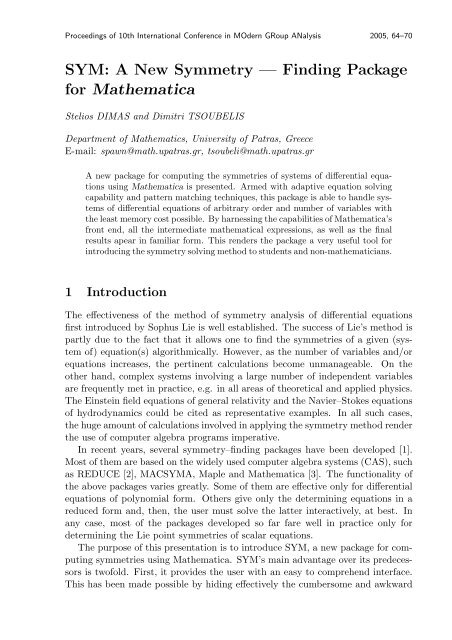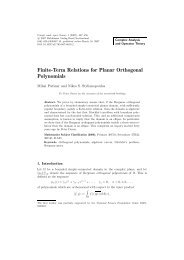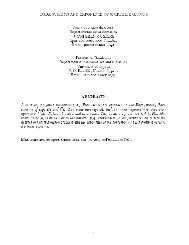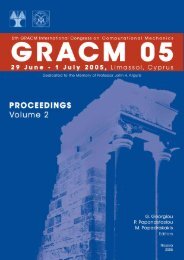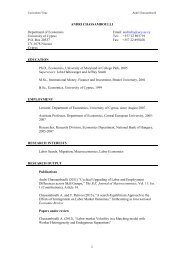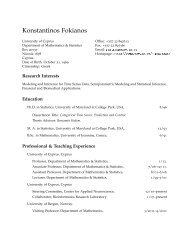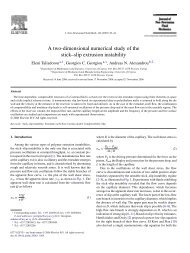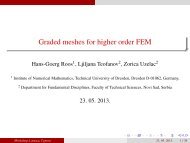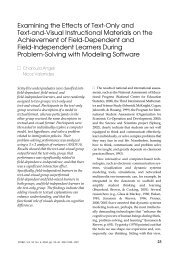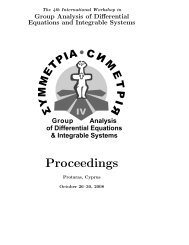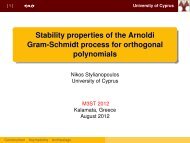SYM: A New Symmetry — Finding Package for Mathematica
SYM: A New Symmetry — Finding Package for Mathematica
SYM: A New Symmetry — Finding Package for Mathematica
You also want an ePaper? Increase the reach of your titles
YUMPU automatically turns print PDFs into web optimized ePapers that Google loves.
Proceedings of 10th International Conference in MOdern GRoup ANalysis 2005, 64–70<strong>SYM</strong>: A <strong>New</strong> <strong>Symmetry</strong> <strong>—</strong> <strong>Finding</strong> <strong>Package</strong><strong>for</strong> <strong>Mathematica</strong>Stelios DIMAS and Dimitri TSOUBELISDepartment of Mathematics, University of Patras, GreeceE-mail: spawn@math.upatras.gr, tsoubeli@math.upatras.grA new package <strong>for</strong> computing the symmetries of systems of differential equationsusing <strong>Mathematica</strong> is presented. Armed with adaptive equation solvingcapability and pattern matching techniques, this package is able to handle systemsof differential equations of arbitrary order and number of variables withthe least memory cost possible. By harnessing the capabilities of <strong>Mathematica</strong>’sfront end, all the intermediate mathematical expressions, as well as the finalresults apear in familiar <strong>for</strong>m. This renders the package a very useful tool <strong>for</strong>introducing the symmetry solving method to students and non-mathematicians.1 IntroductionThe effectiveness of the method of symmetry analysis of differential equationsfirst introduced by Sophus Lie is well established. The success of Lie’s method ispartly due to the fact that it allows one to find the symmetries of a given (systemof) equation(s) algorithmically. However, as the number of variables and/orequations increases, the pertinent calculations become unmanageable. On theother hand, complex systems involving a large number of independent variablesare frequently met in practice, e.g. in all areas of theoretical and applied physics.The Einstein field equations of general relativity and the Navier–Stokes equationsof hydrodynamics could be cited as representative examples. In all such cases,the huge amount of calculations involved in applying the symmetry method renderthe use of computer algebra programs imperative.In recent years, several symmetry–finding packages have been developed [1].Most of them are based on the widely used computer algebra systems (CAS), suchas REDUCE [2], MAC<strong>SYM</strong>A, Maple and <strong>Mathematica</strong> [3]. The functionality ofthe above packages varies greatly. Some of them are effective only <strong>for</strong> differentialequations of polynomial <strong>for</strong>m. Others give only the determining equations in areduced <strong>for</strong>m and, then, the user must solve the latter interactively, at best. Inany case, most of the packages developed so far fare well in practice only <strong>for</strong>determining the Lie point symmetries of scalar equations.The purpose of this presentation is to introduce <strong>SYM</strong>, a new package <strong>for</strong> computingsymmetries using <strong>Mathematica</strong>. <strong>SYM</strong>’s main advantage over its predecessorsis twofold. First, it provides the user with an easy to comprehend interface.This has been made possible by hiding effectively the cumbersome and awkward
<strong>SYM</strong>: A <strong>New</strong> <strong>Symmetry</strong> <strong>—</strong> <strong>Finding</strong> <strong>Package</strong> <strong>for</strong> <strong>Mathematica</strong> 65way the CAS itself represents mathematical expressions. In particular, all the expressionsappearing in both the input and output of the package are representedin the familiar <strong>for</strong>m encountered in the mathematical literature. Moreover, <strong>SYM</strong>is distinguished by its ability to handle and calculate the symmetries of complexsystems of differential equations efficiently and without much intervention fromthe user. This has been achieved by making use of the powerful programminglanguage of <strong>Mathematica</strong>. As a result the package is fast, reliable, and consumesless memory.2 The Sym <strong>Package</strong>The fundamental characteristic of <strong>SYM</strong> is its modularity. This means that it isbased on a specific set of functions which are employed in the symmetry analysisof a given equation. They are functions defined using the well known algorithms ofsymmetry analysis which stems from Sophus Lie’s theory ( [5–8]). In this sectionwe give some further details regarding the features of the program and a fewexamples that illustrate its effectiveness.2.1 Main FeaturesThe basic functions that any symmetry finding package has to per<strong>for</strong>m are [4, 5]:(i) To obtain the determining equations,(ii) To reduce and simplify the system of determining equations, and(iii) To integrate this overdetermined systemBesides complying to the above guidelines, <strong>SYM</strong> carries the following features.• Every infinitesimal generator and its prolongation are defined and used asoperators. Hence, the action of an infinitesimal generator on any algebraicor differential equation can be easily manipulated. This is accomplishedusing the command X[n,{x,y},{u}] which turns the n-th extension of theinfinitesimal operator ξ 1 (x, y, u)∂ x +ξ 2 (x, y, u)∂ y +η(x, y, u)∂ u into a “a purefunction”. Examples where this feature can be exploited are the analysis ofthe invariant surface condition and the supplementary equations involved inthe symmetry analysis of an initial–boundary problem. Likewise, the commandX[n,{x,y},{u,h},2] defines as a pure function the n-th extension ofthe infinitesimal generator in characteristic <strong>for</strong>m:Q 1 (x, y, u, h, u x , u y , u xy , u xx , u yy , h y , h xy , h xx , h yy )∂ u+Q 2 (x, y, u, h, u x , u y , u xy , u xx , u yy , h y , h xy , h xx , h yy )∂ h ,which is needed in the investigation of generalized symmetries.
66 S. Dimas and D. Tsoubelis• The structural elements of the equations to be analyzed are automaticallypinpointed and characterized. This is attained by making the program lookat a differential equation in a human like fashion, using commands likeCharacterizeEq[*]. The latter produces automatically several features ofequation, such as its order, the independent and dependent variables, etc.This feature minimizes the input required, restricting it to the differentialequation or the system of such equations under study, only. The abovecommands not only facilitate the substitutions needed in the process ofautomatically solving the linearized symmetry condition, but they renderthese substitutions easy to materialize in the case the user has to solve theabove system interactively.• An intelligent integrator of the system of overdetermined equations, which isincorporated in the fundamental command SolveOverdeterminedEqs. Enhancing<strong>Mathematica</strong>’s internal one, <strong>SYM</strong>’s differential solver mimics thehuman behavior by following a novel algorithm we call “Seek&Solve”: it locatesthe appropriate equation to solve, substitutes the solution of the latterto the remaining equations and, after making the necessery simplifications,it repeats the previous cycle. Thanks to the various rules and tactics incorporatedin the solver, the program will adapt its solving strategy to thesystem at hand. It terminates only when the complete solution is achieved,or when the remaining equations are not solvable. In this connection, westress that the solver can deal with systems which include equations of nonpolynomial type. All possible differential constraints on arbritary functionscontained in the solutions are given explicitly. In addition, the package providesthe option of printing all the steps followed in obtaining the solution.This feature allows the program’s user to check all the intermediate stepsat any time.• Additional functions <strong>for</strong> manipulating the system’s symmetries are included.<strong>SYM</strong> gives all the generators of the one–parameter subgroups, their commutatortable and the structure constants of the corresponding algebra.• All intermediate and final expressions are presented in a compact and elegantfashion. More specifically, by taking advandage of the expressionmasking capabilities of <strong>Mathematica</strong>, <strong>SYM</strong> presents both the equations tobe solved as well as the intermediate and final results in the familiar <strong>for</strong>mthat one encounters in the mathematical literature. Moreover, these familiarexpressions can be manipulated freely by the user himself.2.2 Illustrative ExamplesThe package has been tested against a variety of differential equations, especiallysystems, from various sources [5–8]. It has also been tested by the interactivederivation of conditional symmetries <strong>—</strong> both point and generalized, of
<strong>SYM</strong>: A <strong>New</strong> <strong>Symmetry</strong> <strong>—</strong> <strong>Finding</strong> <strong>Package</strong> <strong>for</strong> <strong>Mathematica</strong> 67several equations of research interest. The following are characteristic examplesof the equations against which <strong>SYM</strong> has been tested. The last one has beenconsidered, up to now, as the benchmark <strong>for</strong> symmetry–finding packages.(i) The modified Kadomtsev–Petviashvili equation3u yy − 4u xt − 6u y u xx − 6u 2 xu xx + u xxxx = 0 (1)(ii) The generalization of the Ernst equation derived in [9]∂ u(A υ + A2ρ U υ(u, υ) + m A ρρ = 1 2 (υ − u), A = 1 2)+ ∂ υ(A u + A2ρ U u(u, υ) − n A )= 0,ρ(2ρ U uυ+ n − m ). (2)U u U υ U u U υ(iii) The Einstein vacuum equations <strong>for</strong> the Bondi metric [10]β r = rγ2 r2 ,U rr = 2e−2γ(u,r,θ)r 3 (−2e 2β(u,r,θ) β θ − 2e 2γ r 2 U r + e 2γ r 3 U r β r− 2re 2β γ r cot θ + 2e 2β rγ r γ θ − e 2γ r 3 U r γ r + e 2β rβ rθ − e 2β rγ rθ),β θθ = − 1 4 e−4β ( −4e 4β − 8e 2(β+γ) rU(u, r, θ) cot θ − 8e 2(β+γ) rU θ +4e 4β β θ cot θ + 4e 4β β 2 θ − 12e4β γ θ cot θ − 8e 4β β θ γ θ + 8e 4β γ 2 θ −4e 4β γ θθ − 2e 2(β+γ) r 2 U r cot θ + e 4γ r 4 Ur 2 + 4e 2(β+γ) V r − (3))2e 2(β+γ) r 2 U rθ ,γ θθ = −e −2β ( 3e 2γ rU cot θ + e 2γ rU θ − 2e 2β β θ cot θ + 3e 2β γ θ cot θ+ e 2β − 2e 2γ rUγ θ + 2e 2β β θ γ θ − 2e 2β γ 2 θ + e2γ r 2 U r cot θ − e 2γ V r− e 2γ r 2 γ θ U r − e 2γ r 2 U cot θγ r + e 2γ V (u, r, θ)γ r − e 2γ r 2 U θ γ r+e 2γ rV r γ r − 2e 2γ r 2 Uγ rθ + e 2γ rV γ rr − 2e 2γ rγ u − 2e 2γ r 2 γ ur)(iv) The Magneto–Hydro–Dynamics equationsρ t = −∇ · (ρ(x, y, z, t)⃗υ),⃗υ t = −(⃗υ · ∇)⃗υ − 1 ( (∇ p(x, y, z, t) + 1 ))Hρ2 ⃗ 2 (x, y, z, t) − ( H ⃗ · ∇) H ⃗ ,⃗H t = ( H ⃗ · ∇)⃗υ − (⃗υ · ∇) H ⃗ − H∇ ⃗ · ⃗υ, (4)∇ · ⃗H = 0,p t = −kp(∇ · ⃗υ) − (⃗υ · ∇)p.
68 S. Dimas and D. TsoubelisThe Lie point symmetries of the above equations were obtained using <strong>SYM</strong>’sClassicalSymmetries[] function. In the table below we present the time andthe amount of physical memory needed <strong>for</strong> the calculation. The PC used in thetest was a Pentium IV laptop at 3.2GHz with 1GB of physical memory.equation time physical memory1 6.8 sec 6 MB2 95.8 sec 374 MB3 25.1 min 269 MB4 19.4 min 32 MBIn way of comparison, we first mention that MathLie, the symmetry–finding package<strong>for</strong> <strong>Mathematica</strong> developed by G. Baumann [11], wasn’t able to give non–interactively even the determining equations <strong>for</strong> examples (ii)–(iv). On the otherhand, the MAC<strong>SYM</strong>A based package <strong>SYM</strong>MGRP.MAX took 50 minutes of CPUtime on a Digital VAX 4500 with 64MB of RAM <strong>for</strong> deriving only the (222)determining equations of example (iv).The Lie point symmetries of the equations in examples (i) and (iv) are welldocumented [4]. There<strong>for</strong>e we restrict ourselves to presenting the symmetry generatorsof the equations in examples (ii) and (iii). They are given byandX 1 = ∂ u + ∂ υ , X 2 = u∂ υ + υ∂ υ , X 3 = ∂ U , X 4 = U∂ U , X 5 = U 2 ∂ UX 1 = −r∂ r − 2V ∂ V + 1 2 ∂ β + ∂ γ , X 2 = 2r∂ r + 4V ∂ V + ∂ β ,X f1 = f 1 (u)∂ u − Uf 1u ∂ U − V f 1u ∂ V − f 1u2 ∂ β,X f2 = − r 2 (f 2 cot θx + f 2θ )∂ r + f 2 (u, θ)∂ θ +()Uf 2θ + f 2u + e2(β−γ)(f 2θθ + f 2θ cot θ − f 2 csc 2 θ) ∂ U +2r(r 2 (Uf 2θθ + f 2u cot θ + f 2uθ ) + (r 2 U cot θ − V )f 2θ −respectively.(r 2 U csc 2 θ + V cot θ)f 2)∂V + f 2 cot θ + f 2θ43 Applications in Education∂ β + f 2 cot θ − f 2θ∂ γ ,2Because of the familiar way it represents mathematical expressions, its easy touse interface and modular structure, <strong>SYM</strong> can be used effectively in courses onthe symmetry analysis of differential equations. By using it, students can becomefamiliar with the fundamental notions of symmetry analysis much more easily.
<strong>SYM</strong>: A <strong>New</strong> <strong>Symmetry</strong> <strong>—</strong> <strong>Finding</strong> <strong>Package</strong> <strong>for</strong> <strong>Mathematica</strong> 69Because it presents the symmetry construction process in a step by step fashionand allows students to experiment on their own. In addition, the package can beexploited in the context of web<strong>Mathematica</strong>. More specifically, everyone with aninternet access can use <strong>SYM</strong> <strong>for</strong> getting introduced to modern group analysis ofdifferential equations, without having to own the actual CAS.4 Future AdditionsThe symmetry–finding package presented in this talk needs to be further developedand completed. The following are among the additions that would make<strong>SYM</strong> even more effective:• High–level comands that would make it able to automatically calculate conditional,non–local and discrete symmetries,• Tools <strong>for</strong> the construction of recursion operators and master symmetries,• Functions concerning various aspects of the corresponding Lie algebras, suchas their solvability, the optimal system etc., and the group classification ofsolutions.• Differential algebra algorithms which determine the system of determiningequations and specify its solution space [12, 13]AcknowledgementsWe thank European Social Fund (ESF), Operational Program <strong>for</strong> Educational andVocational Training II (EPEAEK II) and particularly the program Irakleitos, <strong>for</strong>funding the above work. We would also like to thank the University of Patras andparticularly the program Karatheodory 2001 <strong>for</strong> funding the above work duringits initial stage of development.[1] W. Hereman, Symbolic software <strong>for</strong> Lie symmetry analysis. CRC Handbook of Lie GroupAnalysis of Differential Equations. Vol 3: <strong>New</strong> Trends in Theoretical Developments andComputational Methods, ed. N.H. Ibragimov, 367–413, CRC Press, Boca Raton, 1996.[2] A.C. Hearn, REDUCE User’s Manual Version 3.5, RAND publication CP78(Rev. 10/93),Santa Monica Cali<strong>for</strong>nia, 1993.[3] Wolfram Reasearch, Inc., <strong>Mathematica</strong>, Version 5.0, Wolfram Reasearch, Inc., Illinois,2003.[4] N.H. Ibragimov (ed), CRC Handbook of Lie Group Analysis of Differential Equations. Vol 3:<strong>New</strong> Trends in Theoretical Developments and Computational Methods, CRC Press, BocaRaton, 1996.[5] P.E. Hydon, <strong>Symmetry</strong> Methods <strong>for</strong> Differential Equations: A Beginners’s Guide, CambridgeUniversity Press, U.S.A. , 2000.[6] N.H. Ibragimov (ed), CRC Handbook of Lie Group Analysis of Differential Equations. Vol 1:Symmetries, Exact Solutions, and Conservation Laws, CRC Press, Boca Raton, 1994.
70 S. Dimas and D. Tsoubelis[7] N.H. Ibragimov (ed), CRC Handbook of Lie Group Analysis of Differential Equations. Vol 2:Applications in Engineering and Physical Sciences, CRC Press, Boca Raton, 1995.[8] P.J. Olver, Applications of Lie Groups to Differential Equations 2nd Ed., Springer–Verlag,<strong>New</strong> York, 1993.[9] A. Tongas, D. Tsoubelis, P. Xenitidis, A family of integrable nonlinear equations of hyperbolictype., J. Math. Phys. 42 (2001), 5762–5784.[10] H. Bondi , M.G.J. van der Burg and A.W.K. Metzner, Gravitational waves in generalrelativity VII. Waves from axi–symmetric isolated systems. Proc. Roy. Soc. A 229 (1962),21–52.[11] G. Baumann, <strong>Symmetry</strong> Analysis of Differential Equations with <strong>Mathematica</strong>, Telos/Springer, <strong>New</strong> York, 2000.[12] E.L. Mansfield and P.A. Clarkson, Applications of the differential algebra package diffgrob2to classical symmetries of differential equations. J. Symb. Comp. 23 (1997), 517–533.[13] G. Carra’Ferro and V.P.Gerdt, Improved Kolchin-Ritt Algorithm, Program. Comput. Software29 (2003), 84–87.


